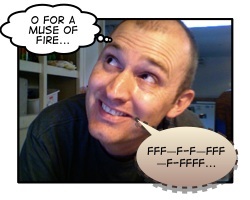Taking it to Text Basics
- This post is available for download as an audio file, so you can do the work along with the recording.
 Now that you've warmed-up your voice and your articulators are going, now's the time to apply this new-found sound/sensation awareness to some language, the text of some play or poem. What you speak at this point doesn't matter too much, but why work on poor quality text, when you can work on the best?
Now that you've warmed-up your voice and your articulators are going, now's the time to apply this new-found sound/sensation awareness to some language, the text of some play or poem. What you speak at this point doesn't matter too much, but why work on poor quality text, when you can work on the best?
For this example, I'll use a portion of William Shakespeare'e Henry V, the very beginning of the first Chorus speech, The Prologue, however you should feel free to use any text that you feel is worthy of your exploration (and that you have memorized). If you don't have anything memorized, you could always learn this one! It begins:
O For a Muse of Fire, that would ascend
The brightest Heaven of Invention:
A Kingdom for a Stage, Princes to Act,
And Monarchs to behold the swelling Scene.
Then should the Warlike Harry, like himself,
Assume the Port of Mars, and at his heels
(Leasht in, like Hounds) should Famine, Sword, and Fire
Crouch for employment. But pardon, Gentles all:
The flat unraysed Spirits, that hath dar'd,
On this unworthy Scaffold, to bring forth
So great an Object. Can this Cock-Pit hold
The vastie fields of France? Or may we cram
Within this Wooden O. the very Casks
That did affright the Air at Agincourt?
O pardon: since a crooked Figure may
Attest in little place a Million,
And let us, Cyphers to this great Accompt,
On your imaginarie Forces worke.
I've taken the liberty of changing some of the more obscure spelling and typographical conventions in the Folio text, and converted those to modern spellings.
So, now we have a text to work on, let's begin by either reading it through aloud or speaking it, also aloud. I cannot stress enough the need to do voice work out loud, that is "on one's voice" and not in your head or in a whisper. The number of times I find students working on an exercise or a text and they're doing it sotto voce or off their voice, would astound you! As you work, give yourself permission to play with your voice, to let the feel of your voice guide you to go beyond your preconceived notions of your voice, and into a new place of discovery and exploration.
FuFFing the Text
As we so often do, I'd invite you to take time with your text to notice your breath. That's how this Basic Warm-up Series began, and it's good to return to that now. Speak the text, and allow your breath impulse to guide you when to breathe. See whether you can breathe based on the "chunks of thought" in the text. Perhaps they will be broken up by the line structure of the text, as the thought process is often revealed in the verse structure of a classical text. Perhaps the punctuation will guide you. Whatever happens, allow yourself to feel your way through the text. Take your time! There is no need to rush your way through.
Now, take some time to let your breath connect with the rhythm and thoughts of the text. Speak the text, but instead of saying the text, replace each syllable with /f/, letting the stresses fall on the important words. Let the /f/ sound be fluffy and fairly noisy (as /f/'s go!), and allow your breath to come as it's needed. Perhaps it will be connected to the thought chunks that you explored above; don't be surprised if this /f/-based version demands more breaths of you, so you're allowing breath more often. Once you've "fuffed" your way through the entire text, now try speaking the text, and see whether the breath connection has had an impact.
Hummming the Text
Finally, let's explore the sound of your voice through the text. Though you don't want to LISTEN to your voice as you're doing this, we do want to explore opening up the possibilities of your voice, and the sound it makes. In the same way that we just explored breath with the "fuffing," Hum your way through the text, replacing every syllable with /m/. It's really important to focus on the ideas of the language, and not worry too much about the sound. Instead, worry about how the ideas create buzziness in your teeth, lips, face and hard palate. How do your ideas get buzzed out? Once you spoken the text through on /m/, immediately speak the text again seeing whether there is a connection between the buzziness and the language.
This is the final step in the Basic Warm-up Series. For suggestions on where to go next, check out the Basic Warm-up Series Conclusion.